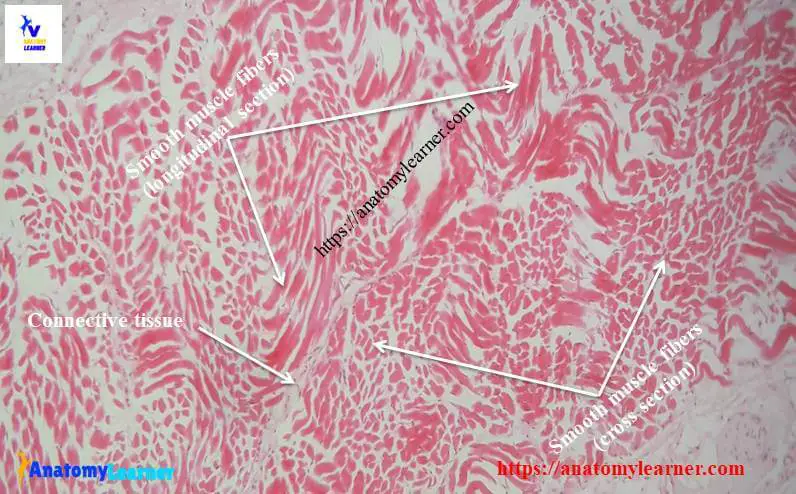There are three main types of muscles in an animal’s body – skeletal, smooth and cardiac muscle. In this short guide, I will show you the different features of the smooth muscle histology slide.
Hi there, welcome back to anatomy learner and thank you so much for learning gross anatomy and histology with anatomy learner. If you are looking for the best short guide to understand the different histological features of smooth muscle, this article is for you.
Here you will learn the smooth muscle location, different histological features from smooth muscle cross section labeled image and smooth muscle longitudinal section labeled images.
After reading this short guide, you will identify the smooth muscle histology slide under a light microscope under the light compound microscope.
Smooth muscle histology
Muscle cells are specialized cells that have a strong and concerted contraction to produce the integrated movement of the animal’s body. These muscle cells are present in the three main areas of the vertebrate body – in the wall of hollow organs, in the skeletal system and the heart. From the smooth muscle histology slide, you might identify the following important histological features.
- #1. Smooth muscle cells or fibres of the longitudinal section
- #2. The nucleus of smooth muscle cells or fibres of the longitudinal section
- #3. Connective tissue surrounds the smooth muscle fibers or cells with fibroblasts
- #4. Cross section of smooth muscle cells
- #5. The nucleus of smooth muscle cells from cross-sectional tissue
- #6. Connective tissue, blood vessels and fibroblast in cross section of smooth muscles
First, you might find these histological features from the smooth muscles labeled images or the video.

Smooth muscle histology slide identification
You may find both longitudinal and cross section in the same tissue sample in a smooth muscle histology slide. I will show you the characteristics features of smooth muscles fibers from both longitudinal and cross section. The muscle cells are arranged in bundles with their long axes aligned parallel to the direction of their contraction.
Following are the important histological features to identify the smooth muscle histology slide under a light microscope.
- #1. Presence of smooth muscle fibers (spindle-shaped) with tapering end in the longitudinal section.
- #2. The nucleus is elongated and placed in the centre of the smooth muscle fibers or cells (in longitudinal section)
- #3. Presence of various shaped and sized cells (resulting from cutting spindle-shaped cells at different places) in cross section.
- #4. Many of the cross sections of the cells lack of nuclear profile, and few shows centrally placed ovoid nucleus in cross section.
So, this is the smooth muscles histology slide (hollow organs)
Want to know the details of smooth muscle? Fine, let’s continue this short guide to learn about smooth muscle.
Smooth muscle longitudinal section labeled
I will show you the light microscopic structure from smooth muscle longitudinal section labeled images. You will find the enlogated, spindle-shaped cells or smooth muscle fibers in the cross sectional histology slide. These smooth muscle cells are tapered at the both ends. Each cell contains a single, elongated, and centrally placed nucleus.
The cytoplasm of the smooth muscle cells or fibers are acidophilic (stains dark). The connective tissue surrounds the individual smooth muscle fibers as well as muscle layers. You will find the fibroblasts, blood vessels in the connective tissue of smooth muscle.
Smooth muscle cross section labeled
Fine, let’s know the characteristics features from the smooth muscle cross section labeled image. In cross section, the spindle-shaped smooth muscle cells will cut at different places along the length of the cell. Thus you will find the various shaped and sized cells in the cross section of the smooth muscle histology slide.
The nucleus may find in the center of these cross sectional cells (ovoid and centrally placed nucleus). But in most of the cross sectional smooth muscle cells lacks the nucleus because of the extends of the cell beyond centar nuclear region.
The individual smooth muscle cell is surrounded by fine network of reticular fibers, blood vessels and nerve fibers. In smooth muscle, reticular fibers are produced by the smooth muscle cells rather than the fibroblasts.
Smooth muscle location and their histological features
Smooth muscles are widely distributed in the animal’s body and predominantly found in the visceral hollow organs and blood vessels.
In the histology of hollow organs like the esophagus, intestine, you will find two concentric layers of smooth muscles in the same section of that particular tissue. You will find inner circular and outer longitudinal layers of smooth muscles in the esophagus, large intestine and small intestine of animals.
Again, you will find a circular arrangement of smooth muscles in the blood vessels histology slide.
This is the basic of smooth muscle microscopic features, but you might also know the fine structures of smooth muscle along with their contraction process.
In fine structure, individual smooth muscles fibers contain the actin and myosin filaments, and they did not contain and striation.
You will also find the numerous vesicular inva(g)zin-eation (different vesicles) of the cell membrane in smooth muscle fibers slide.
Muscle slides images
You already got the smooth muscle histology slide labeled images. But I will updates this article with more real slide smooth muscle images regularly. If you want to get notification on that updates, you may follow anatomy learner on social media.
Again, you may read another article related to basic tissue histology from anatomy learner –
#1. Dense regular connective tissue histology features from real slide images
#2. Characteristics features of hyaline cartilage with labeled slide images
#3. Compact bone histology with identifying characteristics
Also, learn the difference among the histological features of skeletal muscle fibers, smooth muscle fibers and cardiac muscle fibers.
Conclusion
This short guide will help you to understand the basic of smooth muscle histology. I think these slide pictures of smooth muscles were helpful.
If you find any mistake in smooth muscle cross section labeled images or smooth muscle longitudinal section labeled images, please let me know.
Don’t forget to share this article with your friends who want to know smooth muscle histology with real slide pictures. Thank you so much, and stay connected with anatomy learner for more articles.

